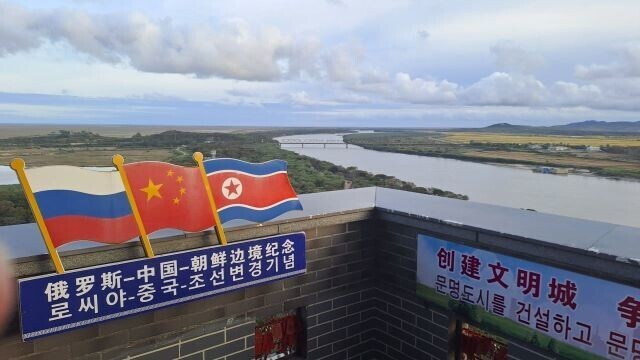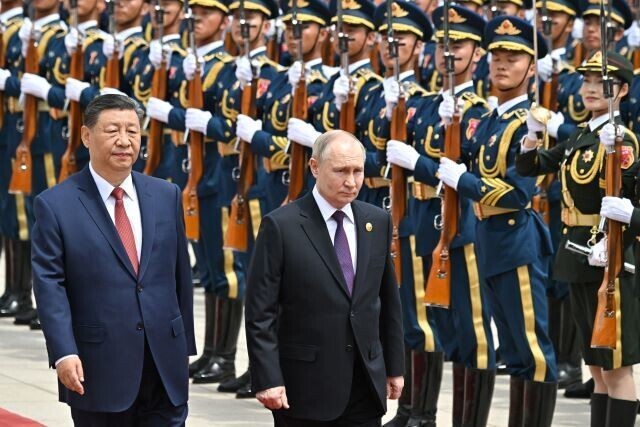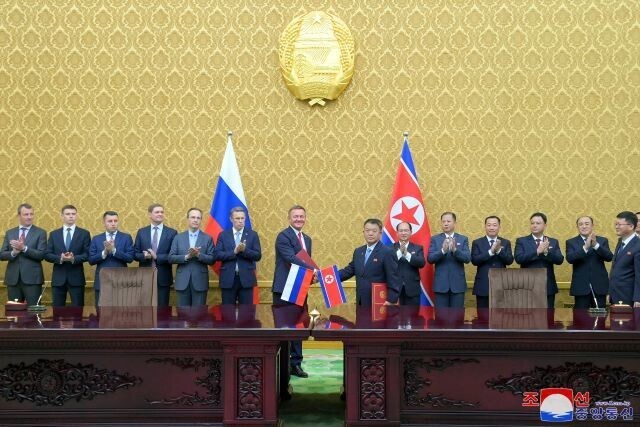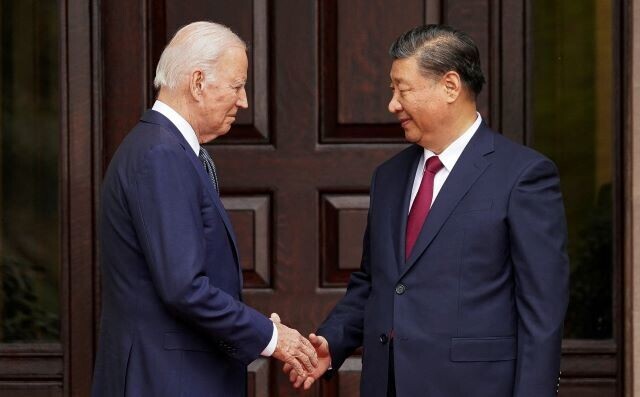hankyoreh
Links to other country sites 다른 나라 사이트 링크
How 17 km of river could be a fertile bed for NK-China-Russia cooperation

North Korea, China and Russia are accelerating the pace of cooperation around their national borders. The key factors driving that cooperation are Russian President Vladimir Putin’s meeting with Chinese President Xi Jinping in Beijing on May 16 and Putin’s meeting with North Korean leader Kim Jong-un in Pyongyang on June 19.
The three countries’ current cooperation is centered on the tripoint between their borders on the lower stretches of the Tuman River, also known as the Tumen. Xi and Putin held “constructive dialogue with North Korea” about the question of allowing Chinese ships to navigate the lower Tuman River to the sea, while North Korea and Russia agreed to build a “motorcar bridge over the River Tuman on the DPRK-Russia border.”
The tri-border area on the lower Tuman River connecting the North Korean city of Rason, the Chinese city of Hunchun and the Russian area of Khasan is regarded as having major economic potential for this corner of Northeast Asia.
Generally speaking, there are two major factors that will determine the pace and direction of trilateral cooperation. The first is whether Kim will visit China this year, which marks the 75th anniversary of the establishment of diplomatic relations between the two countries. The second is whether the three countries can overcome subtle differences in their strategy vis-à-vis the US. It’s widely thought that the success of trilateral cooperation on the lower Tuman depends on the outcome of these two issues, which are themselves interconnected.

China and Russia’s “May agreement”
The first moves were made by the Chinese and Russian leaders. In a joint statement, the two sides committed to holding constructive dialogue with North Korea on the question of allowing Chinese ships to navigate the lower Tuman River to reach the ocean. The basic idea is to use trilateral deliberations to help China compensate for its lack of a harbor or shipping lane to the East Sea (also called the Sea of Japan), which is connected to the Pacific Ocean.
While China’s border with North Korea runs for 1,334 km along the Tuman and Amnok (Yalu) rivers, its eastern terminus is Fangchuan, a village in Hunchun, Jilin Province. The remaining 16.93 km of the Tuman, which runs from Fangchuan to the East Sea, forms the border between North Korea and Russia and thus lies outside of Chinese sovereignty.
That was the result of the Qing Dynasty of China forfeiting 600,000 square kilometers of land in the area to the Russian Empire under the 1860 Convention of Peking, a series of unequal treaties China was forced to reach with the UK, France and Russia following its defeat in the Second Opium War.
China, Russia and North Korea have engaged in numerous deliberations about the issue since the Communist victory in the Chinese Civil War in 1949, but China has yet to regain access to the East Sea. That is why former Chinese President Jiang Zemin once described a sea route as “a dream of history.”

North Korea and Russia’s “June agreement”
The official announcement following Kim and Putin’s summit did not contain any mention of granting Chinese ships access to the East Sea. That said, North Korea’s Ministry of Land and Environment Protection and Russia’s Ministry of Transport did announce that they had signed an agreement about building a vehicle bridge across the Tuman.
The only border crossing on the lower Tuman at present is a rail bridge called the Korea–Russia Friendship Bridge. That bridge began as a wooden structure in 1952 and was upgraded to a steel rail bridge in 1959.
The new agreement between North Korea and Russia envisions building a vehicle bridge between Tuman River Station in North Korea and Khasan Station in Russia to serve as a border crossing and expand trade and travel between the two countries. But that would be bilateral cooperation between North Korea and Russia, rather than trilateral cooperation with China.
![North Korean leader Kim Jong-un sits in the passenger seat as Russian President Vladimir Putin drives around the gardens at the Kumsusan State Guesthouse in Pyongyang, where the two “develop[ed] rapport” after signing their comprehensive strategic partnership pact on June 19, 2024. (KCNA/Yonhap)](https://flexible.img.hani.co.kr/flexible/normal/640/425/imgdb/original/2024/0626/2617193897665698.jpg)
Kim Jong-un’s “leverage” over China
It should not be assumed that North Korea is opposed to granting China access to the East Sea, however. A former official in the South Korean government who is familiar with Pyongyang-Beijing relations told the Hankyoreh on Tuesday that “the question of China’s access to the East Sea is an important bargaining chip that Kim Jong-un can use with Xi Jinping.” If Kim is to sit down with Xi during a visit to China on the 75th anniversary of the two countries’ establishment of diplomatic relations, in other words, he needs to keep an ace up his sleeve.
Meanwhile, unusual currents have been detected in North Korea-China relations, even after Kim and Xi jointly declared on Jan. 1 that 2024 would be the “year of DPRK-China friendship” for the two sides.
Analysts have further suggested that the North Korea-Russia agreement may be meant as a preliminary measure to lay the groundwork for trilateral cooperation, since the Tuman River bridge is an antiquated structure with a low 7-meter height that blocks the passage of larger ships.

Cracks in “anti-US solidarity”?
Differences in strategies toward the US are a key variable determining the future of trilateral cooperation. China supports the idea of a “multipolar” international order to take the place of a unipolar one, as stated in the agreement between North Korea and Russia.
But many observers are suggesting that China is not in a position to fully join in the kind of anti-US solidarity that Pyongyang and Moscow have been emphasizing.
In contrast with North Korea and Russia, which have effectively lost any economic ties to the US and other Western countries due to intensive sanctions, China is closely connected with those economies, having “overinvested” in the post-Cold War “global economic order.”
Indeed, Xi remarked while in San Francisco on Nov. 15 of last year that China was “ready to be a partner and friend of the United States” and that “Planet Earth is big enough for the two countries to succeed.” His words pointed to a search for ways of coexisting — a different direction from North Korea and Russia’s “anti-US solidarity.”
This amounts to a reversal of the conflicts between China and the Soviet Union that arose in the late 1950s after Joseph Stalin’s death, with the Soviets advocating “peaceful coexistence” in opposition to North Korea and China’s approach of “uncompromising struggle against US imperialism.”
It is also worth noting that the issue of East Sea access represents a preliminary step in a strategic effort that the Chinese government has been pursuing with the opening of an Arctic route making use of the Tuman River.
A former senior South Korean government official suggested, “Trilateral cooperation on the Tuman River's lower course is a gauge of strategic cooperation by North Korea, China and Russia, and China’s ability to obtain East Sea access is a gauge of trilateral cooperation on the Tuman River’s lower course.”
“If a China visit by Kim Jong-un happens within the year, there’s a possibility that an agreement will be reached in connection with China’s East Sea access,” they predicted.
Based on this analysis, the primary basis for gauging trilateral cooperation by North Korea, China, and Russia will be the question of whether a North Korea-China summit will happen in the second half of 2024.
By Lee Je-hun, senior staff writer
Please direct questions or comments to [english@hani.co.kr]

Editorial・opinion
![[Editorial] Silence won’t save Yoon [Editorial] Silence won’t save Yoon](https://flexible.img.hani.co.kr/flexible/normal/500/300/imgdb/original/2024/0701/681719819632087.jpg) [Editorial] Silence won’t save Yoon
[Editorial] Silence won’t save Yoon![[Column] The miscalculations that started the Korean War mustn’t be repeated [Column] The miscalculations that started the Korean War mustn’t be repeated](https://flexible.img.hani.co.kr/flexible/normal/500/300/imgdb/original/2024/0630/9717197068967684.jpg) [Column] The miscalculations that started the Korean War mustn’t be repeated
[Column] The miscalculations that started the Korean War mustn’t be repeated- [Correspondent’s column] China-Europe relations tested once more by EV war
- [Correspondent’s column] Who really created the new ‘axis of evil’?
- [Editorial] Exploiting foreign domestic workers won’t solve Korea’s birth rate problem
- [Column] Kim and Putin’s new world order
- [Editorial] Workplace hazards can be prevented — why weren’t they this time?
- [Editorial] Seoul failed to use diplomacy with Moscow — now it’s resorting to threats
- [Column] Balloons, drones, wiretapping… Yongsan’s got it all!
- [Editorial] It’s time for us all to rethink our approach to North Korea
Most viewed articles
- 1Yoon’s prosecutors are throwing everything at the president’s opponents to see what’ll stick
- 2Japan is building a military meant for more than self-defense — and has the US to thank for it
- 3[Editorial] Silence won’t save Yoon
- 4NewJeans rocks Tokyo Dome as new, younger generation of K-pop fans emerges in Japan
- 5[Column] The miscalculations that started the Korean War mustn’t be repeated
- 6Dreams of a better life brought them to Korea — then a tragic fire tore them apart
- 7What made Korea’s lithium battery plant fire so deadly
- 8‘Disposable’: How illegal temp work practices push migrants in Korea into risky jobs
- 9Moonbin of K-pop group Astro dies at 25
- 10[Editorial] Exploiting foreign domestic workers won’t solve Korea’s birth rate problem